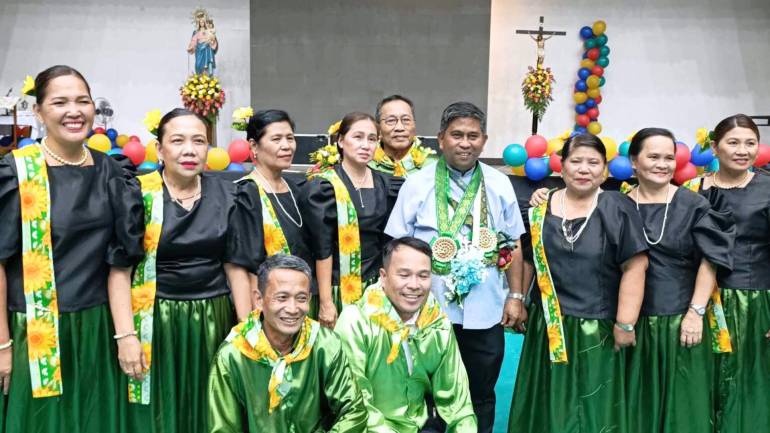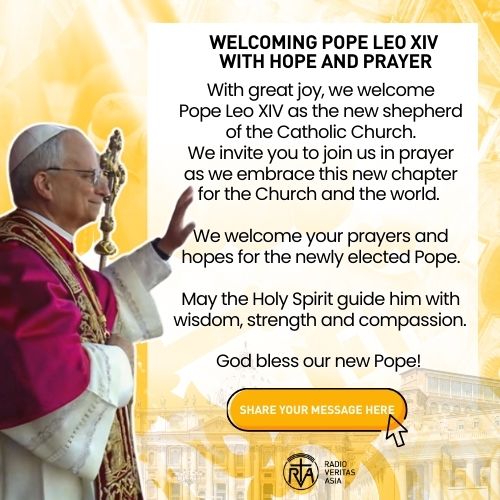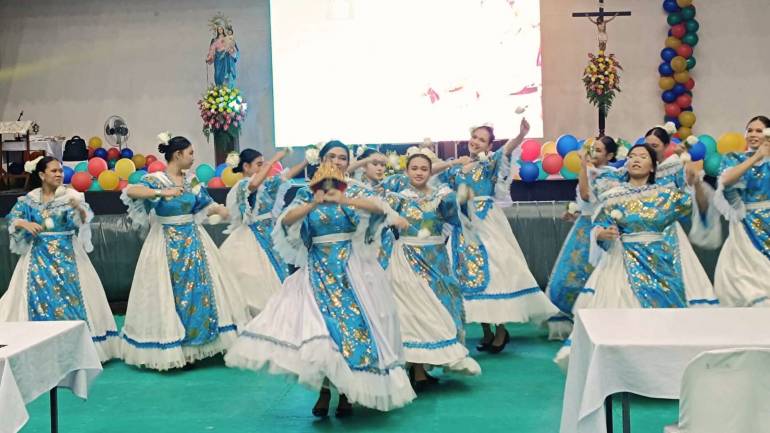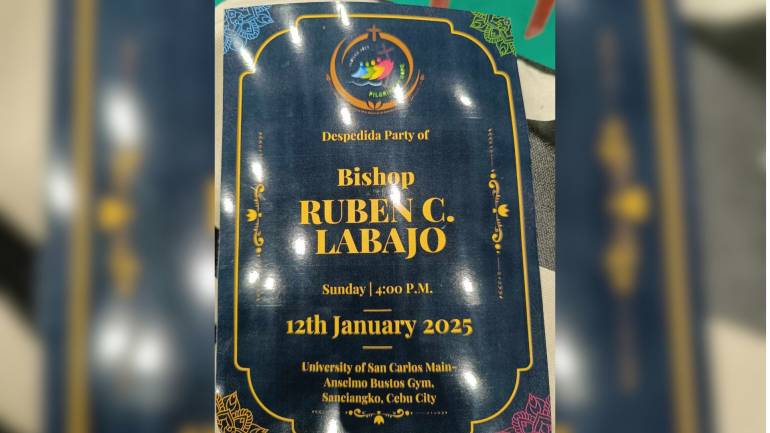Inspiration for the Faithful, a role model for the clergy

It may not be unusual to show such overwhelming esteem for a popular member of the clergy, but when people organize a series of fellowships to show honor, offer gifts, and then travel and spend at least two days in another province to witness a historic milestone, that's taking appreciation to a new level.
The gathering included approximately 40 bishops, primarily from Mindanao; 300 priests from various dioceses; the Apostolic Nuncio to the Philippines, Archbishop Charles John Brown; Cardinal Jose Advincula from the Archdiocese of Manila; key officials of the Catholic Bishops’ Conference of the Philippines (CBCP); friends; lay leaders; and supporters from Cebu, including some town mayors, a former Chief Justice, parishioners, and state officials from two Agusan provinces.
They all gathered in the capital town of Agusan del Sur to welcome Ruben C. Labajo as the first bishop of the newly created Diocese of Prosperidad in the Philippines.
On the eve of his canonical possession and installation, Bishop Labajo was treated to a night of cultural dances, songs, welcome speeches, greetings, and seemingly endless selfies with well-wishers. The following day’s civic reception after the liturgical rites was also impressive.
The vibe was similar to a series of send-off gatherings organized by former parishioners, friends, and supporters from four different parishes where he served in various offices for three decades: as episcopal vicar of the national shrine of St. Joseph in Mandaue City; as team moderator of the St. Joseph the Worker Parish in Tabunok, Talisay City, Cebu Metropolitan Cathedral, St. Francis of Assisi in Balamban in western Cebu, and the Sto. Rosario parish in Cebu City, his last parish assignment before he was appointed first bishop of the Diocese of Prosperidad.
Three days later, former parishioners in Santa Fe town on the island of Bantayan prepared a separate program to honor their former parish priest. The local government unit earlier conferred the status of honorary citizen on Labajo for his distinguished service to the local community.
Much earlier, the Archdiocesan Commission on the Laity and groups under the Archdiocesan Marian Council held their respective gatherings to wish the bishop well and to give him gifts for the journey ahead.
Dauntless Faith
When Fr. Labajo was assigned to Santa Fe, Bantayan Island, in 1999, he took charge of the Sto. Nino parish church, which is located along the main road across from an Aglipayan church also named Sto. Nino church.
Cebu is considered a Catholic stronghold; however, Santa Fe had a thriving Aglipayan church. In a talk with Fr. Roland Anthony Torres, a member of the team of pastors in Cebu City’s Santo Rosario parish church and a close confidante of Bishop Labajo, the Aglipays have a substantial majority of at least 60% of the local population.
Aglipayans refer to members of the Philippine Independent Church founded by Gregorio Aglipay in 1902. He was an activist priest excommunicated by the Church for his involvement in revolutionary activities against the Spanish Roman Catholic clergy and for his affiliation with Freemasonry.
Interviewed by RVA News during the fellowship of former parishioners, friends, and supporters at the San Carlos gymnasium in Cebu City last January 12, 2025, Labajo said it was not unusual to see his parishioners going to the Catholic church and afterward crossing over to the Aglipayan church whenever it suited them. They did not see anything wrong because the independent church practices Catholic liturgy and celebration.
Labajo said he did not criticize the practice nor utter negative comments about the independent church. Instead, he took steps to help people understand better the Catholic faith. For example, he initiated the celebration of “Pope’s Day” in the parish united with the Solemnity of Saints Peter and Paul, which is marked by the universal church every June 29. For Bishop Labajo, “Pope’s Day” is a celebration that the Aglipayan church cannot copy.
It was in Santa Fe where Fr. Torres witnessed an incident that surfaced; according to him, the dauntless faith of Labajo.
On December 23, 1999, while stationed in the parish church of Santa Fe town, Fr. Labajo prepared to travel by boat to the neighboring islet of Kinatarcan to officiate a wedding ceremony.
Despite the raging storm and the apprehensions of parish workers, he set out for Kinatarcan. His future bride's family had prepared and sent invitations, so canceling the wedding was impossible. He left for Kinatarcan in the morning, hoping that the storm would subside and eventually pass by.
Unfortunately, the storm became more intense. In the afternoon, it was learned that a commercial ferry with more than 600 passengers sank in the heavy waters. Many died in the sea mishap. Fr. Labajo’s boat also went missing, giving rise to fears that he may have perished.
The situation prompted then-Cebu Archbishop Ricardo Cardinal Vidal (now deceased) to call on the Philippine Navy to launch a search and rescue operation.
As the day wore on, large waves swamped over Bantayan and neighboring islands, cutting off communication in the area. The dire weather prompted the regional naval force not to mobilize for a search and rescue operation.
Amidst the uncertainty about Fr. Labajo’s safety, the Cebu Archdiocese launched a prayer vigil asking God to bring home the priest safely.
Interestingly, members of the Aglipayan church in Santa Fe also organized a prayer vigil for the Catholic priest, according to Fr. Torres.
After more than 10 hours, a local fisherman along the coastal barangay (village) of San Remigio town finally rescued Fr. Labajo at nightfall.
Taking to heart the teachings of Pope Francis, “to come out and to go to the peripheries.”
While serving as team moderator for the St. Francis of Assisi parish in Balamban (2019-2022), Fr. Labajo decided to bring the sacraments to the remote areas. The topography of Balamban, located west of Cebu, is generally rocky and mountainous, where travel can be risky.
After traveling more than two hours from the town proper to the mission area, Fr. Labajo climbed up Balamban’s steep mountainsides. Due to his lack of experience in challenging environments, Fr. Labajo collapsed after ascending just over a hundred feet. Fortunately, he did not sustain serious injuries and celebrated mass and other sacraments in the remote mountain barangays. In the process, he saw firsthand the appalling poverty of the people in the mountains.
According to Fr. Torres, he expected Labajo to feel bad and regretful about the experience, but he felt happy about the pastoral visit to the mountains. “Nalipay gyud ko” (I’m very happy), Fr. Labajo told his confrere about the otherwise dangerous experience.
Following his appointment as the Cebu auxiliary bishop in 2022, Labajo relocated to Cebu City to be in closer proximity to the archdiocese’s seat. He later became the team moderator of the Sto. Rosario Parish.
One of Bishop Labajo’s legacies, seen to last through generations, is the Parish Education Assistance Program (PEAP). Initiated during his stint in the St. Joseph the Worker Parish in Talisay City, Cebu (2012-2018), PEAP is a collaborative effort with a Manila-based foundation. The program started by granting financial assistance to some 20 indigent children in 2012.
Coming from a humble family, Bishop Labajo understands the struggle of poor families since he was able to study in the seminary and finish a degree in sacred theology through the kindness of a benefactor.
The program currently sustains the secondary education of some 15-20 students. During the fellowship with former parishioners, some 20 youngsters who benefited from PEAP showed up to present songs and dances to honor Bishop Labajo.
Lay volunteer and PEAP coordinator Tessie Bacalso told RVA News that one key lesson she learned from working with Labajo is to be with those you serve and to help them in their struggles.
“His closeness to the people gave them a sense of belonging and acceptance,” Ms. Bacalso said.
In cooperation with parish volunteers headed by Dave Deriada, together with clergy serving the Cebu Metropolitan Cathedral parish, Labajo initiated the setting up of a clinic for poor parishioners. A regular nurse and doctors staff the clinic, providing free services according to predetermined schedules.
He also spearheaded major renovations in the parish church of Sto. Rosario in Cebu City and Tabunok, Talisay City, as well as robust family life and formation programs in the parishes.
Former parishioners in the National Shrine of St. Joseph, led by Louie Aliviado, also reminisced about the days when Labajo served the parish (1994–1997).
As an episcopal vicar under the then Most Reverend Antonio Rañola, Fr. Labajo was tasked with raising funds to undertake major repairs and renovate the church. The old ceiling and century-old roof required replacement, forcing the church to close for four years. They completed the massive task in six years.
According to Socorro Sanchez, a lay volunteer and old-timer in the parish pastoral council, Fr. Labajo came up with all sorts of events to raise funds, from ballroom dancing contests to raffle draws.
Louie Aliviado, another lay volunteer in the National Shrine of St. Joseph parish, said that after Labajo was transferred to Santa Fe in Bantayan Island, he and lay volunteers would visit their former parish priest in Bantayan. Parish and family updates are the usual topics during simple meals. For Aliviado, Labajo is not just a priest but a friend and mentor.
In response to the overwhelming love and support from lay leaders and parishioners, Labajo said he is grateful that he was able to accomplish projects in the different parishes.
He revealed that as a pastor, he tried his best to be a father to his parishioners—someone that people could be assured of help and care from, but people remained distant. He then joins parishioners in small and large gatherings to get to know them better and what’s going on in their lives. The change in direction worked wonders for Labajo.
He also said that throughout his 30 years of service in different parishes, he never got into a quarrel with anybody.
“One cannot avoid differences of opinion. There were instances when an irate parishioner would angrily confront me for one reason or another,” he said in Cebuano.
He would approach the situation by calmly explaining his side of the matter.
Disagreements happen because the other side does not fully understand the issue, according to Bishop Labajo.
For her part, Sr. Geralyn Fernandez, the Superior of the Schoenstatt Sisters of Mary Philippines, said that Bishop Labajo is supportive of the religious community.
“He draws people to the church because of his humility. When I first met him in Bantayan, somehow, I foresaw that he would become a bishop one day,” Sr. Geralyn said.
Fr. Dennis Baricuatro, team moderator of the St. Joseph the Worker parish church in Talisay City and a former schoolmate in the local seminary, said, Bishop Labajo is “a natural leader. As a friend, he is easy to get along with. He is transparent in his dealings.”
Reynald Andales, the Vice President of World Apostolate of Fatima (WAF) International, shared his key takeaway from working with Bishop Labajo, which is to always value everyone equally.
“Everyone is important; there should be no distinction,” Mr. Andales recounted Bishop Labajo’s advice to the WAF.
“He is an inspiration for the lay and a role model for the clergy,” was how Andales summed up his impression of Bishop Ruben Labajo.
Radio Veritas Asia (RVA), a media platform of the Catholic Church, aims to share Christ. RVA started in 1969 as a continental Catholic radio station to serve Asian countries in their respective local language, thus earning the tag “the Voice of Asian Christianity.” Responding to the emerging context, RVA embraced media platforms to connect with the global Asian audience via its 21 language websites and various social media platforms.















